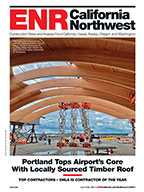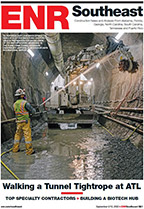In what politicians at an Aug. 12 briefing overlooking Ground Zero repeatedly termed an "historic" event, the federal government has agreed to earmark $4.55 billion for a transportation mega-hub there that New York state and city officials will have "flexibility" to manage. While there are a number of projects on agencies' wish lists, observers say details could be caught up in political infighting at the former World Trade Center site and must await the results of November elections.
The funding is not new federal money but part of President George Bush's previously announced $21-billion federal aid package to the city following the Sept. 11, 2001, terrorist attacks. The funding, announced by Fed- eral Emergency Management Agency and Federal Transit Administration officials, allows local officials not merely to rebuild transportation infrastructure destroyed in the attacks but to develop a grand scheme at the WTC site that could link the Port Authority Trans-Hudson lines (PATH) from New Jersey with several city subway lines as well as improve bus, ferry and other commuter lines. "This is the first time that FEMA has allowed a local community to use funds this way," said New York Gov. George Pataki, who has been lobbying Washington for months along with other city and state officials.
Politicians joining Pataki at the announcement noted that $2.75 billion of the FEMA package is funding left unspent from cleanup of Ground Zero, which was completed under budget and ahead of schedule. "We're here with these dollars because of the people who worked at this site," said Sen. Hillary Rodham Clinton (D-N.Y.). Another $1.8 billion was already included in an earlier Bush administration supplemental appropriations bill.
The dedicated transportation funds would propel a number of transportation upgrades that agencies, particularly the Port Authority of New York and New Jersey, already have on the drawing board. This includes a new $1.5-billion "permanent" PATH terminal that could be built at the existing WTC location (see diagram) or farther east near Church St. A decision on the exact location would affect costs for a concourse between that terminal and a future transit center linking several city subway lines. "The decision must be made in the next couple of months," says one project source. A temporary PATH station and related tunnel work will be finished next year.
Also unclear is the fate of a $2-billion plan to depress West St., a key WTC-area artery, to unite key downtown areas. "That could take a long, long time," says one official. A partial depression plan is one alternative.
More definitive plans will depend on clearer resolution of the controversial Sept. 11 memorial at the site and on Pataki's bid for re-election. But "the focus may now shift from above to below," says one observer.
Clinton also noted hurried efforts to press Bush to sign appropriations legislation that includes $90 million to expand efforts to fully test workers for possible respiratory and other ailments from work at Ground Zero since September. "The legislation must be signed by Aug. 31 or it dies," says Paul Fernandes, chief of staff for the New York Building and Construction Trades Council. "This would cover everyone who needs the service. We really don't know the full exposure to airborne contaminants."
The latest news and information
#1 Source for Construction News, Data, Rankings, Analysis, and Commentary
JOIN ENR UNLIMITEDCopyright ©2024. All Rights Reserved BNP Media.
Design, CMS, Hosting & Web Development :: ePublishing



Post a comment to this article
Report Abusive Comment